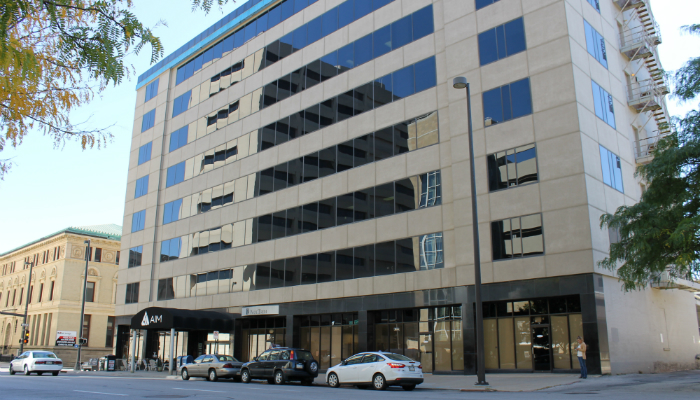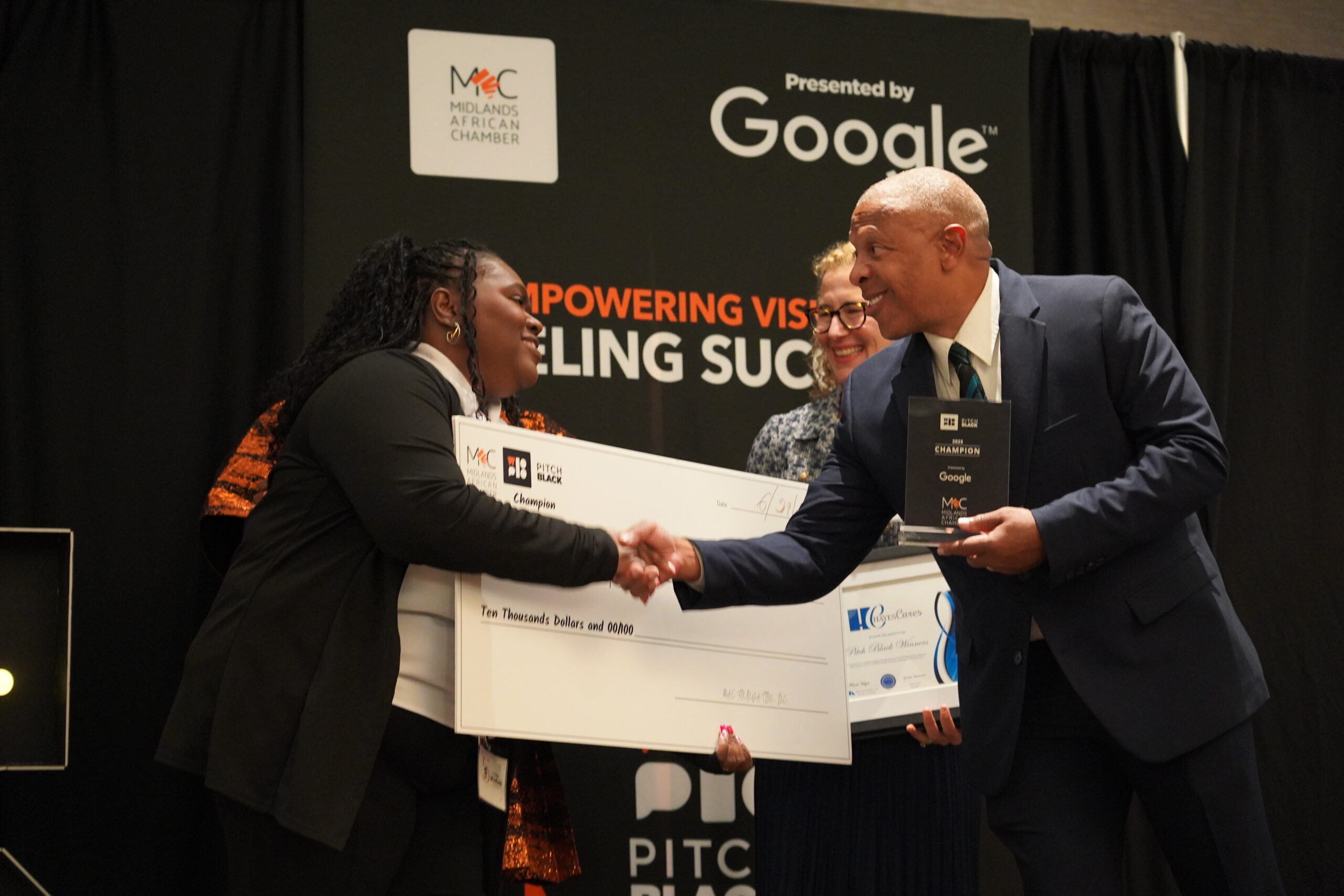
The 100-year-old Exchange Building at 19th and Harney in Omaha is quickly transforming into Omaha’s central startup hub.
In recent years startup communities have popped up in major cities across the U.S. In nearly every case their growth has been driven by a central location where creative, talented people can bump into each other and collaborate.
“Look at a Kansas City or at Denver 10-20 years ago, at Chicago five years ago, and you see these different players of the community form bigger alliances,” said Erica Wassinger, co-founder of the Omaha Startup Collaborative.
Des Moines has Gravitate. Saint Louis has T-REX. But what about Omaha? There’s a lot happening in the community, from events like Big Omaha to the Garage by Aviture out west to the Scott Technology Center and, most recently, the Year of the Startup.
“We’ve got events, we’ve got programming, so if you have an idea you can develop a network. What we don’t have in Omaha yet is the proximity of innovative, disruptive thinkers on a regular basis. The closest thing we have today is One Million Cups,” said Wassinger.
Many in the community believe that solving the density/proximity issue is what the startup community needs to reach the next level of maturity.
An alliance between the Omaha Startup Collaborative and the AIM Institute this year may finally give the startup community the rally point it’s been looking for.
OSC models itself on successful incubators
The Omaha Startup Collaborative was developed by Mark Hasebroock, Peter Frei and Erica Wassinger as a way to bridge the gap between startup enthusiasm and building companies with real traction.
“When Hasebroock, Peter and I looked at what Omaha needed, we had a lot of community building events, we had a lot of cheerleaders and support, but there was a disconnect between that and really accountable actionable startups that were willing to focus on traction, growth and sales,” said Wassinger.
As part of their research, they visited over two dozen incubators and coworking spaces across the country.
“We’ve studied everything from how they vet their startups to how they design their space to how they structure their operating budget and who they hire,” Wassinger said.
The most successful incubators combine exclusive access to mentors, programming, content and events–as well as the ability to work alongside other startups.
One of the lessons OSC discovered was the importance of having all the major community players in the same space.
“What we learned is that it can’t be just the startups in there, it has to be the whole ecosystem,” said Wassinger.
Wassinger particularly likes the Galvanize network with spaces in Denver, Boulder and San Francisco. They combine startup spaces with a code school and a venture fund in the same building.
“You can see the code school talent being snapped up right away into the startups, and startups don’t have this massive tech talent drain that everyone complains about,” said Wassinger. “You also saw deals happen because of the connections that come with having VCs nearby.”
Wassinger also sees value in the exclusivity and accountability of spaces like the Atlanta Tech Village and 1871 in Chicago. (Notably, ConAgra will be moving its HQ from downtown Omaha to Merchandise Mart, the same location as 1871. Access to talent and innovation were the primary reasons given for the move.)
There’s also another incubator space in the Silicon Prairie that the OSC wants to emulate.
“One location that I can’t say enough good things about, and honestly what we hope to become, is Think Big in Kansas City,” said Wassinger. “I think what Herb, Blake and the entire team down there have done is take a community that was somewhat risk averse and just kept betting on it.”

AIM opens its doors to the startup community
Although Omaha Startup Collaborative started in May of 2014 in Creighton’s Wareham Building, the Exchange project came together due to an introduction by the Omaha Chamber of Commerce.
“They were the ones that said, ‘I think there’s some space at the AIM building. And if you need, they could be a really good partner for you,’” said Wassinger.
It was around that same time that AIM acquired Silicon Prairie News and Big Omaha. When OSC and AIM each shared their vision for the future of the Omaha tech community, it was clear there was mutual benefit.
“Kandace [Miller] is such a visionary and really knows where she wants to take AIM in terms of its ability to anchor an innovative community, not just in this building but in the region. It took one conversation to know that we have way too many good things aligning here for us not to make it work.”
Since June over 20 startups have started paying membership fees, including Drive Spotter, Crumb, Blabfeed and a Travefy satellite office. They have been accessing the mentor pool, attending events and participating in monthly accountability meetings. The OSC is now operating on three full floors of the Exchange Building.
The Exchange Building is also home to the Interface Web School, the Straight Shot accelerator and Omaha’s weekly One Million Cups gathering–as well as regular youth coding classes put on by AIM and, this summer, Omaha Code School.
“AIM is easily underestimated and they really shouldn’t be”
“It’s somewhat mindblowing when you think of the investment Kandace and the entire AIM team is making in the startup community,” said Wassinger.
For years now AIM has been a relatively quiet supporter of the community.
“AIM is easily underestimated and they really shouldn’t be,” said Wassinger. “They can rock it, and they can really make change happen.”
AIM is equally excited about the remodeling of the building, and the new energy in the space.
“What I love about Erica is that she’s always up to try something and to try it now. To see if it works, adjust and move forward. That’s exactly how we work,” said Kandace Miller, CEO of AIM.
In the past AIM has brought longevity and growth to community events like Infotec and HDC in order to strengthen the tech talent community. AIM sees itself as an investor in nonprofit startup service providers.
“We want to invest in services like OSC, Big Omaha and SPN, because they are so important,” said Miller. “We’re going to do what it takes to make sure they make it.”
The future of the Exchange
The warming relationship of the Chamber, AIM and the Omaha Startup Collaborative marks a new chapter for the Omaha startup community.
“I think we’re starting to smash a lot of the silos that had been an issue in the past,” said Wassinger.
And although the Omaha Startup Collaborative takes lessons from other communities, Wassinger looks forward to the building having its own unique vibe.
“At the end of the day we’re not going to be like an incubator in San Francisco, that’s not our ethos,” said Wassinger.
The key is creating a place where all the major community players can participate.
“In two to five years, this building could be the anchor for youth education in tech talent. This could be the anchor for venture funds in this community. It could be a major hub,” said Wassinger. “We could have this beautiful masterpiece in Omaha that from an economic development standpoint could be a major draw for talent.”
The OSC has now opened coworking space in the Exchange building for $50 per desk per month, which includes free tickets to events like the Exchanges With series, access to a mentor network and an invitation to exclusive happy hour events. To apply, visit OmahaExchange.co.
—
Editor’s Note: Silicon Prairie News and Big Omaha were acquired by AIM in January 2015. SPN maintains its offices in the Exchange Building.
Ryan Pendell is the Managing Editor of Silicon Prairie News.





9 responses to “Will the AIM Exchange finally solve Omaha’s density problem?”
I love to hear that Erica and Peter have found a way to make their idea work, and if I had stayed in Omaha I’d be there (I used their Creighton location before I moved), but these sorts of statements are really indicative of the insulated bubble that “startup culture” people live in:
“In nearly every case their growth has been driven by a central location
where creative, talented people can bump into each other and
collaborate.”
That is just plain innaccurate. You’re mistaking community for growth – classic “forest for the trees” mistake in perception.
These sorts of things help a narrow sliver of business startups. The vast majority of freelancers, people jumping into owning a business, weekend warriors and the like don’t go to these things. They don’t drive the growth of small businesses – they drive the growth of the *startup scene*, which has a great effect for that narrow band of entrepreneurs that make use of them, but is nowhere near the driver of growth overall.
For every person who uses a coworking space or goes to startup culture events, there are dozens who just have day jobs and work on their side-business at home, or already have made the jump and work from small offices of their own, home offices, coffee shops, etc. The sort of material that is covered at “startup events” only pertains to a sliver of the overall entrepreneurial space – the vast majority of businesses never even try to get angel investment / venture capital, for instance.
I’ve been looking more into this, as I found out that 1 Million Cups fizzled here in Vegas (where I moved). I’m working on bringing it back here, and we’re making a concerted effort to do so in a way that isn’t just for young, tech-hipster startup culture types, but also is just as welcome and useful for the regular small business owners that outnumber startup types dozens to one, live outside of that bubble and are actually the engine that research shows is behind the job growth that our country so badly needs.
Well said, Solomon. I’m kinda at a loss why the folks in Omaha never visited the Haymarket in Lincoln to talk with folks in the community to learn what worked and didn’t work. I do not think creating a “space” does much of anything to actually move the needle on growth. No one thing is the center or driver of the growth of new companies, and those who believe that will take the wrong approach every time. The business leaders that have and are succeeding, by and large, have done it without being at all these events and being in these “collaborative” spaces. They are simply executing and asking specific people for help when they need it.
I actually disagree on details (but agree with your overall sentiment) your point of it not doing “much of anything” – it’s just this inflated / hyperbolic thing they said about the success of business growth in other cities being “driven” by startup hubs like this. It can do great things, it’s just not remotely the biggest thing, most important, etc – outside of the small portion of the economy that startups make up.
They live in a bubble, and either forget or never learned that the people who are active in the startup community represent a small fraction of the overall business activity going on in a city.
As I said – if I was still in Omaha, I’d be in that space and would assuredly love it. It’s great, but they’re full of themselves if they think punching out a few successful startups a year (which is awesome – I hope they get there) could drive the Omaha economy.
It can do it’s part, but it’s just plain egotistical to ignore the vast majority of the economic activity churning in Omaha and pretend like this one nook of it is more important than any other. Most of my clients are small to medium sized business owners, and I’ve found that they have vastly more to teach than the people you usually see speaking at startup events (I’m going to experiment with this here in Vegas actually… going to try and get more old school business owners to speak at an event I’m helping get re-started) – that bubble man… it’s stifling.
You say it better than I in that last part:
“The business leaders that have and are succeeding, by and large, have done it without being at all these events and being in these “collaborative” spaces. They are simply executing and asking specific people for help when they need it.”
In my opinion the story is really about Omaha’s trend toward removing that “bubble” by connecting more community partners. Connecting the startup scene with players like the Chamber and AIM opens up the startup community to the tech and business communities and offers potential relationships exactly as you’ve described.
The people behind OSC and the Exchange share the same gut feeling, in my opinion, as you and Steve. Ok, we have some events, but how do we get from there to traction, growth, customers, sales.
I didn’t criticize their work – quite the contrary – and didn’t say anything contrary to what you’re saying the article is about. I’m a big fan of their efforts. As I said, I used their space over by Creighton from time to time (I work mostly from home and coffee shops, but it was nice to have a third option).
All I criticized are the parts about it “driving” the economy or “solving Omaha’s density problem”, and the mindset that those sorts of thoughts spring from.
It would be awesome if they were able to connect the wider business community to the startup community – the latter has a lot to learn from the former.
I’m not following, Steve. Do you think that Omaha folks should both visit the Haymarket to see what works and also dismiss the idea that something like the Haymarket is worth pursuing?
Have you found any benefit to having Nebraska Global companies in the same building? Or do you think that’s a distraction?
The article said they visited two dozen incubators and co-working spaces. But not a 45 minute drive to Lincoln to learn from the Haymarket area in Lincoln? My point is that the concept that all the “players” should be in the same space is misguided. Very specifically, the players in Lincoln are NOT in the same space. The Haymarket is an appropriately-sized area of town with a wide variety of ingredients such that it has become, generally, the area where young companies and other “players” either are located or meet. You can walk around and observe in the coffee shops, the restaurants, the street corners, and other random places and you’ll see discussions, collaborations, and interactions of people from different companies, different disciplines, etc. It is NOT about one building, one space. It’s the opposite. No one is trying to own it, no one is trying to be everything. I think there is a general viewpoint here, in general, that different things, different places, different ideas are better than one space, one idea, one way. I would challenge folks to find another place in the Midwest with more density than the Haymarket in Lincoln. And more importantly, folks should look at the CHANGE in density from 5-7 years ago. I think few places have grown as much as the business community in and around the Haymarket and downtown Lincoln. There is certainly benefit in having some companies in the same building and in the main Nebraska Global office. But it’s not the only way we do it. We specifically do not want everyone in one place because I think that’s less optimal. But it’s my opinion. If folks in Omaha want to copy what other places have done and try and make a building the hub, that’s fine. But I don’t think it will work in the ways they think it will, and there are plenty of examples in other cities that confirm that view. Galvanize is not everything in one space. I do not believe a building should be the hub. I don’t believe there should be a hub at all. The ecosystem should be decentralized and evolving on all fronts and distinctly free of any anchor. Otherwise the ecosystem is completely reliant on the health of the hub. I think there is a misguided view that physical space density is the only measure of density in an ecosystem. It’s not. People drive. People walk. People use Skype. They don’t need to be housed together to interact. Silicon Valley proves that to the extreme. People drive an hour without thinking about it in order to meet with someone.
Are you sure they didn’t visit the Lincoln spaces? Maybe they just didn’t mention them?
Way to go, Big-O! Good to encourage original thought and business creation. Here in Cedar Rapids, IA, we are proud of our Vault co-working and Iowa Startup Accelerator, doing similar work.